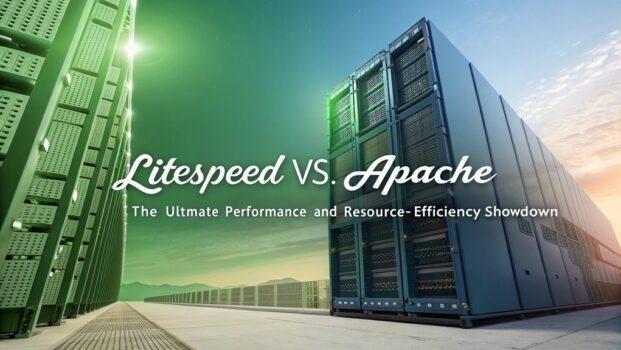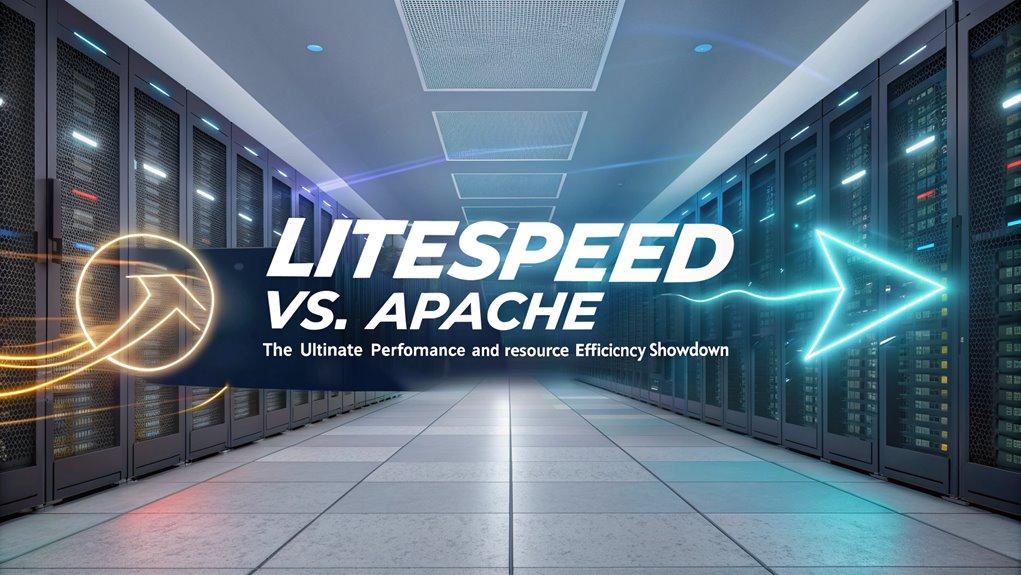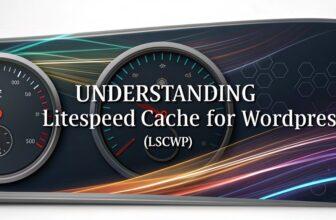LiteSpeed drastically outperforms Apache, boasting average response times of 95 milliseconds against Apache’s 4,000. With the ability to handle 2,400 clients compared to Apache’s 59, LiteSpeed’s event-driven architecture delivers stable, efficient performance and resource usage. Despite requiring a paid license for advanced features, its compatible with Apache configurations ensures a smooth transition. Plus, LiteSpeed’s security enhancements streamline site protection. There’s more to discover about LiteSpeed’s significant advantages over Apache.
Key Facts Summarized
- LiteSpeed’s average response time is significantly faster at 95 milliseconds compared to Apache’s 4,000 milliseconds.
- LiteSpeed efficiently manages up to 2,400 clients, while Apache struggles beyond 59 clients per second.
- LiteSpeed’s event-driven architecture provides stable latency and efficient resource use, unlike Apache’s approach.
- Apache is open-source and free, whereas LiteSpeed’s advanced features require a paid license.
- LiteSpeed integrates user-friendly security features, including mod_security for WAF and anti-DDoS, with minimal configuration.
Performance Comparison: Litespeed Vs Apache
When comparing the performance of LiteSpeed and Apache, it’s clear that LiteSpeed takes the lead with its superior speed and efficiency.
LiteSpeed achieves an impressive average response time of 95 milliseconds, significantly outperforming Apache’s sluggish 4,000 milliseconds.
In high-traffic scenarios, LiteSpeed handles up to 2,400 clients seamlessly, while Apache struggles beyond 59 clients per second, showcasing substantial performance issues.
LiteSpeed’s event-driven architecture ensures stable latency and efficient resource usage, with server loads between 20% and 45%, contrasting sharply with Apache’s higher consumption.
Moreover, LiteSpeed’s built-in caching solutions further enhance its capabilities, whereas Apache requires additional configurations to catch up.
Benchmark tests decisively show LiteSpeed can manage 5 to 10 times more requests, cementing its position in resource efficiency.
Compatibility and Transition Considerations
Transitioning from Apache to LiteSpeed is streamlined by LiteSpeed’s full compatibility with Apache configurations, ensuring you won’t need major modifications.
With support for Apache’s mod_rewrite rules, you maintain your existing URL structures effortlessly. This compatibility simplifies the transition process within your server environment, making it efficient and less error-prone.
- Seamless Configuration: LiteSpeed supports Apache configurations, reducing setup time.
- URL Structure Maintenance: Apache’s mod_rewrite rules are fully supported, preserving link integrity.
- Cross-Platform Flexibility: Both servers run on various operating systems, aiding compatibility.
- Enhanced Management: LiteSpeed’s compatibility with cPanel facilitates server management.
- Community Resources: Extensive Apache community support aids during transitions.
These factors make LiteSpeed an attractive option for users familiar with Apache, ensuring minimal disruption during migration.
Security Features and Enhancements
After ensuring a smooth migration to LiteSpeed from Apache, it’s crucial to turn your attention to the security features each server offers.
LiteSpeed vs Apache server security is a critical consideration, especially with LiteSpeed’s built-in optimizations. It integrates mod_security for WAF capabilities and offers anti-DDoS features, providing enhanced website safety. Additionally, LiteSpeed includes bandwidth and connection throttling, streamlining protection without extensive configurations.
On the other hand, Apache’s robust security features require more configuration to reach optimal levels. However, its expansive community offers vast resources for tackling security issues, making it a reliable choice.
Despite its stability and reliability, Apache’s security tools mightn’t be as user-friendly as LiteSpeed’s, which are designed to offer comprehensive protection right out of the box.
Cost and Licensing Implications
Considering the cost and licensing implications of LiteSpeed and Apache is vital when selecting a server solution.
LiteSpeed provides a free version, but advanced features demand a paid license, which could strain budgets. Apache, as an open-source web server, remains entirely free, appealing to those seeking no-cost operations.
LiteSpeed’s non-open-source nature restricts customization, unlike Apache’s flexibility for modifications and community-driven enhancements.
When evaluating LiteSpeed, think about the return on investment, especially in high-traffic environments where performance gains may justify costs.
Apache’s extensive documentation and community support offer financial benefits by reducing troubleshooting expenses.
- LiteSpeed free version available; advanced features need a license
- Apache is completely open-source and cost-free
- LiteSpeed limits customization; Apache offers flexibility
- Evaluate LiteSpeed’s ROI for high-traffic scenarios
- Apache’s community support cuts troubleshooting costs
Community Support and Resources
While evaluating server solutions, the community support and resources available for Apache and LiteSpeed play a crucial role in your decision-making process.
Apache boasts a vast community, providing extensive documentation that aids troubleshooting and facilitates learning. This comprehensive support network ensures you can efficiently solve issues, especially beneficial if you’re new to server management.
Conversely, LiteSpeed’s community is still growing, and its limited documentation can pose challenges, impacting your ability to find immediate solutions. Transitioning from Apache to LiteSpeed involves a learning curve due to configuration differences, underscoring the importance of robust community support.
Apache’s open-source nature encourages community-driven development, enhancing its resource pool, whereas LiteSpeed’s proprietary structure may limit immediate assistance and documentation depth.
Frequently Asked Questions
Is Litespeed Faster Than Apache?
Yes, LiteSpeed is faster than Apache. You’ll notice that LiteSpeed delivers content significantly quicker, with a response time of just 95 milliseconds compared to Apache’s 4,000 milliseconds.
Under heavy loads, LiteSpeed maintains stable latency, efficiently handling up to 2,400 clients without timeouts. Apache, on the other hand, struggles beyond 59 clients per second.
Additionally, LiteSpeed’s built-in caching boosts performance, eliminating the need for extra configurations like with Apache.
What Is the Fastest Open Source Web Server?
When you’re looking for the fastest open-source web server, Nginx often tops the list. It uses an event-driven architecture, allowing it to efficiently manage high traffic with low resource consumption.
Tests show Nginx excels in handling static content and concurrent connections. However, if dynamic content is your focus, LiteSpeed can outperform due to its built-in caching.
Both offer impressive performance metrics, so your choice depends on specific needs and server configurations.
Who Are Litespeed Competitors?
Like a racehorse in a field of ponies, LiteSpeed’s competitors include Apache and NGINX.
Apache offers a buffet of features and stable performance, securing a firm grip on the market.
Meanwhile, NGINX shines with its minimal memory usage and prowess in managing substantial traffic loads.
Despite their strengths, both fall short in speed, as LiteSpeed boasts superior response times and handles more concurrent requests, making it the go-to for performance enthusiasts.
Is Litespeed Better Than Nginx?
Yes, LiteSpeed often outperforms NGINX, especially under high-traffic scenarios.
You’ll find LiteSpeed’s average response time impressively lower at 95 milliseconds, while NGINX struggles with higher latency.
With LiteSpeed’s built-in caching, PHP applications run smoother, making it a strong choice for WordPress.
Under heavy load, LiteSpeed maintains stability, efficiently utilizing resources to handle more requests compared to NGINX, which encounters performance issues at lower thresholds.
Conclusion
In choosing between LiteSpeed and Apache, consider your specific needs. For instance, a high-traffic e-commerce site might thrive on LiteSpeed’s superior performance metrics and resource efficiency, enhancing page load times and reducing server strain. However, if you’re running a small blog, Apache’s cost-effectiveness and robust community support might be more appealing. Ultimately, your decision should weigh factors like compatibility, security, and licensing. Each server has unique strengths that can be leveraged for optimal results.









